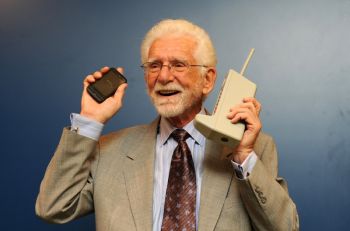art @ IIT: Two new exhibits at the Galvin Library at IIT through January 20
Ellen Sandor (art)n–
Multi-Dimensional Imagery: 3D Pixels Realized
For more than twenty-five years, PHSColograms, the integration of photography, holography, sculpture, and computer graphics, have created a post-canvas three-dimensional medium that has expanded the visual imagery of the work of a variety of scientists, mathematicians, engineers, architects, and artists.
The PHSCologram term, coined in 1983 by Ellen Sandor, is an acronym for photography, holography, sculpture and computer graphics. A PHSCologram, pronounced skol-o-gram, is made by dividing slightly different views of one subject into thousands of very thin vertical columns.
These columns are interleaved to make a single image, which is then laminated onto the back of a Plexiglas panel. A black film with thin clear vertical lines called a barrier screen is laminated onto the front of the panel. The slits in the barriers screen allow the columns from only one of the original views to be seen from a particular angle. Each eye sees a slightly different view of the subject, and the brain condenses these two views into a three-dimensional image. As you scan across the image, the changing views from each column of the image further enhance the three-dimensional effect.
The PHSColograms in this exhibit represent all the methods and techniques developed over the years. The subject matter involves artistic and technical collaborations with scientists, mathematicians, engineers, architects, and artists. Each collaboration attempts to expand our visual experience; to better understand a technical aspect of the original imagery or to enhance the communication of the content and the artistic intent of the image.
Ellen Sandor is an internationally recognized multimedia artist and pioneer in digital media. Throughout the 1970s, she created mixed media environments and sculptures, and received an MFA from The School of the Art Institute of Chicago. Her passion for photography, technology, and outsider art inspired her to invent a new methodology for producing art, and a new medium of expression for the digital age. Since the early 1980s, a large body of work has been produced under Sandor’s direction by the (art)n collective and numerous collaborators, with works in the permanent collection of museums and private patrons.
Jan Dean
inside outside - attraction repulsion
Paradox. The vessel is a metaphor of our human existence, the body symbolized as a box or bowl is the vessel for the soul. The paradox is between the need to belong and the need for individuality; attraction and repulsion; the inside and the outside; material expansion and contraction. Living in western culture in the late 20th century demands the individual address and deal with issues of material existence. We use modern materiality to defend our personal space, regarded as precious, and we use it to reach out and interact with the world. Dean includes a series of ceramic pieces with a seemly incompatible set of the materials.
Dean earned a MFA from the Cranbrook Academy of Art and has exhibited widely in the Midwest. Her professional experience as instructor, consultant and curator has included: South Suburban College, Richard J Daley College, The Notebaert Nature Museum, Lill Street Ceramic Studios, Urban Gateways, The School of the Art Institute of Chicago at Gallery 37and The Museum of Contemporary Art.
These exhibits are curated by Robert J. Krawczyk, art @ IIT Gallery Director, Associate Professor in the College of Architecture.
An artist reception will be held on Thursday, November 16, 4:30 - 7:30 pm., presented in the Kemper Room Art Gallery, Paul V. Galvin Library, Illinois Institute of Technology, 35 West 33rd Street, Chicago; the exhibits run from November 9, 2006 through January 20, 2007. Hours are Monday - Thursday: 12 - 6 pm; Friday: 12 - 5 pm; Saturday: 8:30 am - 5 pm; and Sunday: 2 - 6 pm. The exhibit is free of charge and open to the public. Directions to the gallery are available at art @ IIT.
Founded in 1890, IIT is a Ph.D.-granting university with more than 6,700 students in engineering, sciences, architecture, psychology, design, humanities, business and law. IIT's interprofessional, technology-focused curriculum is designed to advance knowledge through research and scholarship, to cultivate invention improving the human condition, and to prepare students from throughout the world for a life of professional achievement, service to society, and individual fulfillment.




